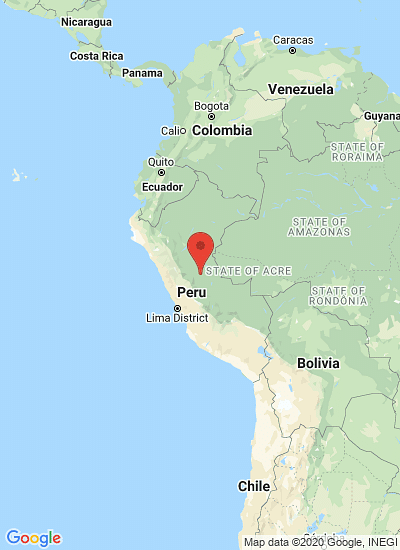Selection of Andean wild potatoes. (Courtesy: International Potato Center: CIP, Peru)
Native Potatoes: From Forgotten Crop to Culinary Boom and Market Innovation
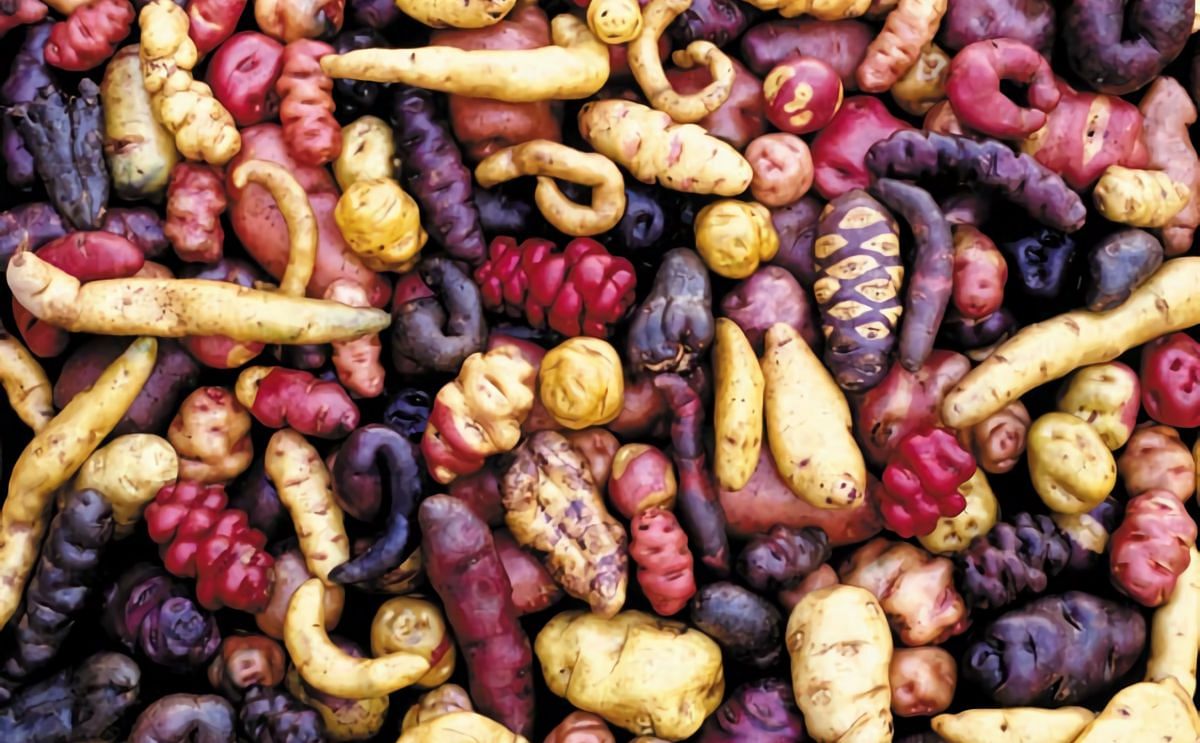
Once neglected by urban consumers, Andean native potatoes are now essential ingredients for some of the most sophisticated gastronomy of the world. From colored chips to delicacy vegetables and even liquors, new products are making their way into high-income market niches.
At the same time, native potatoes continue to fulfill their basic role of providing food security for many rural households in the Andes, who were responsible for domesticating them. Today, these families continue to plant native potatoes in diverse varietal mixtures which could contribute to longer term adaptation to climate change.
The International Potato Center (CIP) found an opportunity for repositioning potato as an added-value cash crop. CIP has accomplished this by expanding its use for processing and by encouraging sales of improved and native potatoes to satisfy preferences of consumers in emerging markets in small and large cities and export markets.
This article examines how potatoes—particularly native potatoes—can improve livelihoods among poor farmers in Peru, highlighting the role of biodiversity as a resource to link small producers with markets. It offer examples with an approach to foster pro-poor innovation in value chains, the Participatory Market Chain Approach (PMCA), which was originally developed to increase the competitiveness of small-scale potato producers by taking advantage of the diversity of native potatoes.
These native potato varieties have been successfully marketed to consumers who link them with Peru’s cultural heritage and who wish to support traditional, small-scale farming with relatively low external inputs.
The Potatoes of Peru
In Peru, production and consumption of potatoes have grown significantly, reaching 83 kg per capita consumed annually in 2017 compared to the average per capita consumption in Latin America of 25 kg (FAO, 2020). The renaissance in potato output and area planted in Peru over the last 20 years has been a remarkable development in the region, traceable to public and private policies, investments in rural infrastructure, expansion of supermarket trade, and a strong relationship with the gastronomy sector to promote Andean food and products.
Advances in poverty reduction in Latin America in recent decades have largely by-passed the remote and mountainous areas of the Andes, where families live with limited assets in terms of land, capital, and market access. More than 4,000 varieties of potatoes are still grown in this part of the world, where they have been planted for 7,000–10,000 years.
Andean farmers in Bolivia, Ecuador, and Peru grow native potatoes adapted to high altitudes, consuming and selling them to meet household needs. Potato biodiversity and social capital created among its growers represent unique resources that partially compensate for small-scale farmers’ limited assets. Promoting collective action among farmers and strengthening interaction with market agents and agricultural service providers can transform native potatoes into a source of competitive advantage (Meinzen-Dick, Devaux, and Antezana, 2009).
The terms “native potatoes” and “native varieties” are used to denote landraces or local potato varieties that have been developed by domestication and selection of very diverse local genotypes which are highly valued by Andean farmers. Native varieties differ from “improved varieties,” the latter being the products of formal potato breeding programs deliberately seeking particular standards and traits, such as broad adaptation, high yield, and resistance to pests or diseases.
Conserving native potatoes in situ (in farmers’ fields) and ex situ (in genebanks) is supported by research and development institutions such as CIP. Because native potatoes grow better at higher altitudes (above 3,300 meters above sea level), where smallscale farmers predominate, CIP decided to focus on them in a regional initiative, Papa Andina, to support development based on market innovations.
Focusing on native potatoes was a “poverty filter” to give a competitive advantage to the poor Andean farmers who grow them (Thiele and Devaux, 2011). This approach brought together research organizations and value chain partners with a goal of enhancing an array of complementary technological and institutional innovations.
Market Development for Native Potatoes in Highland Peru
Until the early 2000s, most large farmers in Peru cultivated a handful of improved potato varieties for sale in urban markets, while smallholders primarily grew native varieties for home consumption, selling little in nearby local markets. Small-scale farmers’ high transaction costs, poor connection to markets, limited access to information, and low negotiation capacity limit their access to larger, more dynamic markets in major cities that could be more profitable (Escobal and Cavero, 2012).
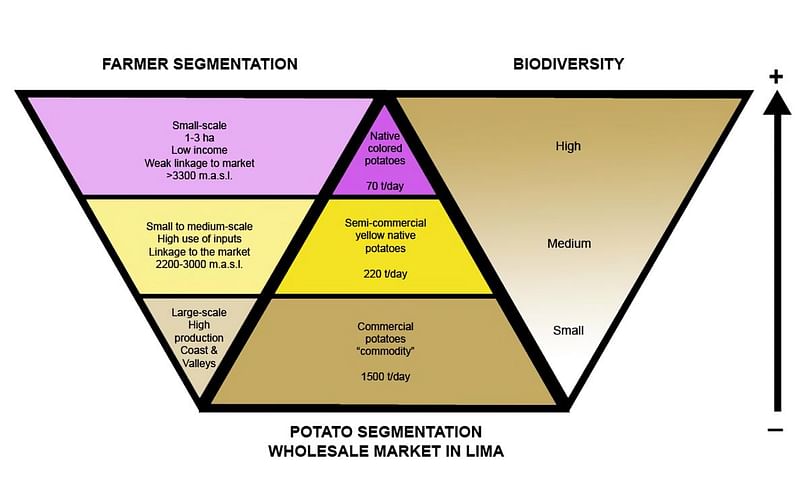
Segmentation of the Potato Market in Lima, Peru (Source: Based on Ordinola et al. (2011)).
From a market perspective, the Peruvian potato market is segmented into three main sectors: white improved potatoes or commercial potatoes, yellow native potatoes, and colored native potatoes. White potatoes are primarily grown for cash by large-scale farmers, who have a comparative advantage because of scale, market, and information access.
Linked to the preferences of urban consumers, yellow native potatoes are well positioned in the national market and can be described as semi-commercial. They also have potential for export to Peruvians living abroad, mainly in the United States.
Last, colored native potatoes represent the highest biodiversity level but were, until recently, still an unexploited resource with potential to be promoted in local supermarkets as a gourmet product linked to specific visual, nutritional, and cultural characteristics. Increasing concerns about food quality and safety have also stimulated demand for locally grown foods, including native potatoes from the high Andes (Ordinola et al., 2011; Shimizu and Scott, 2014).
Addressing small-scale farmers’ marketing constraints was an important entry point for CIP’s Papa Andina initiative. National macroeconomic and agricultural sector policies that began in the 1990s in Peru had created a favorable context for this type of approach. The policy developments were complemented by increasing international recognition of Peruvian cuisine and a new image of potatoes as a source of national pride—both of which stimulated domestic demand. Meeting this demand for native potatoes meant improving product presentation and quality as well as ensuring a regular supply to consumers year-round.
Product development: The Participatory Market Chain Approach (PMCA)
PMCA is a flexible innovation approach that brings together smallholder farmers, market agents, researchers, and other service providers in a structured process to identify and exploit potential business opportunities that benefit farmers as well as others who participate in the value chain (Bernet, Thiele, and Zschocke, 2006). It involves a sequence of activities usually implemented over 12–18 months.
Initially, research and development (R&D) professionals play key roles facilitating the process. Later, as value chain actors build trust between each other, agree on common goals, and become more actively engaged, R&D professionals recede from the leading role and support the process and methods.
PMCA has three distinct phases. During phase 1, R&D professionals conceptualize and identify the value chain through a value chain diagnostic and map the actors, their interests, and challenges. Phase 2 aims to generate and assess alternatives for improving marketing in specific selected products (in this case native potatoes).
This phase involves group work by value chain actors and service providers with the support of R&D professionals. In phase 3, development work begins on promising commercial innovations.
Early successes may encourage individuals and groups to continue interacting and innovating in the future. As a result, this interplay can generate other types of innovations, such as technological adjustments for farmers, new product development, and novel changes to create an enabling institutional environment.
From 2001 to 2010, the regional Papa Andina initiative aimed to improve the competitiveness of Peru’s potato sector, working with more than 20 public, private, and non-governmental organizations to stimulate potato production and marketing (Devaux, Ordinola, and Horton, 2011; Ordinola et al., 2011). The implementation of PMCA, led by CIP, identified commercial innovations working with supermarkets, processing companies, culinary schools, and the media to raise the profile and uses of new products of native potatoes for high-value markets domestically and for potential niche markets abroad.
This work triggered innovation processes that benefited participating farm families and Peru’s potato sector as a whole, improving market access for smallholder farmers and generating recognition of their role in the conservation of the native potato diversity. This PMCA also provided a diverse group of stakeholders in the native potato value chain with their first opportunity to explore options and develop innovations that could mutually benefit farmers, processors, chefs, and sellers at different market stages.
During the implementation of PMCA, CIP worked with several local agricultural service providers to meet the technical needs of farmers and processors to capitalize on new market opportunities. Interest from large-scale market players led to the creation of an array of new potato-based products and different brands of native potato chips of superior quality, ranging from products of multinationals such as Frito Lay and the Peruvian-based Gloria Group to those produced by small local companies in response to markets’ diverse demands.
CIP continued to support the development of Peru’s potato sector and innovation processes, working with policy makers, engaging in public awareness and policy incidence, and building capacity for local organizations. The initial success attracted the interest of other organizations to promote the use of native potatoes as a gourmet product for export markets.
AGROPIA, a farmer organization in the Huancavelica region, with the support of Agronomes et Vétérinaires Sans Frontières (AVSF) and the non-government organization Centro de Desarrollo Integral de Comunidades (CEDINCO), supported the production and sales of colorful blue and red potato chips that were introduced in the European organic and fair trade markets under the brand Ethiquable. After obtaining Fair Trade certification in 2012, AGROPIA also earned an organic farming certification to penetrate the international and national markets in high-end sectors.
With the support of the local municipality of Huancavelica, this initiative made it possible to revitalize the production of native potatoes in this mountainous territory as a strategy to fight poverty. Today, the 150 family members of AGROPIA are earning higher incomes thanks to the high prices offered by the fair- trade export markets and high-value national niche markets. As another innovation in the private sector, the company Inka Crops exports native potato processed products and coordinates with approximately 25 farmers’ associations in the regions of Junín and Huancavelica in the highlands of Peru. Its destination markets are the United States and Europe under the Peruvian Potato Chips brand, and Inka Crops is the currently main exporter of native potatoes (Agraria.pe, 2020).
In these contexts, the PMCA “triggered” an innovation process whereby the second and third generation of innovations, which emerged after the PMCA exercise, continued to evolve and were often more important than those developed during the initial application of the PMCA approach.
Outcomes of PMCA
The suite of complementary and new interventions significantly increased the supply of and demand for native potatoes in Peru, opened export markets for new products, and generated benefits for small-scale producers, processors, and other actors along the value chain. By 2010, farmers growing native varieties were selling 28% of their harvest compared to 60% for those growing improved varieties.
However, this represented a 40% increase in native potatoes sales since 2000, compared to a 5% increase for improved varieties over the same period. Since farm-gate prices had also increased, especially for native potatoes, total value of production for potatoes rose during the period.
Between 2000 and 2011, the value of sales of improved and native potato varieties increased by 67% and 159%, respectively. An estimated 70,000 farmers are selling native potatoes (Horton and Samanamud, 2013).
More recently, the World Bank estimated that the value of total native potato exports in Peru (snacks, frozen, dehydrated, and fresh) increased from USD 821,000 in 2010 to USD 2.5 million in 2015, following the increased trade between the Andean region and export markets. Nearly 70% of this value came from the snack category, which would include potato and native potato chips, among other products (World Bank, 2017; Málaga, Avila- Santamaria, and Carpio, 2019).
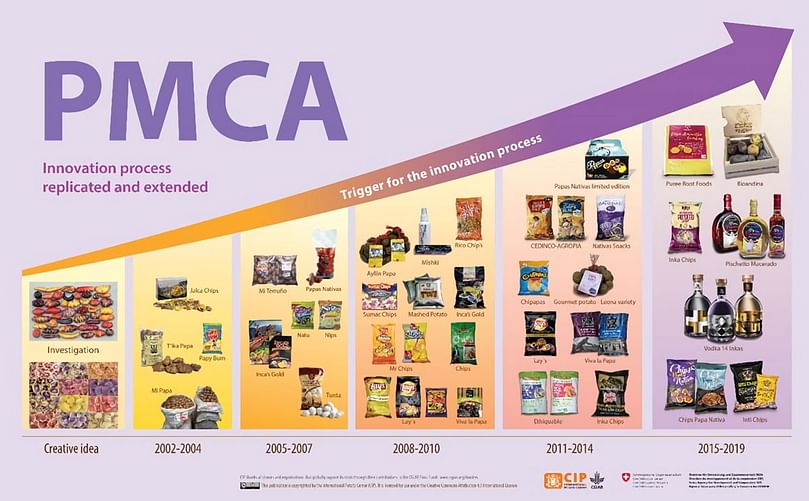
PMCA’s Influence on Innovation in New Potato Products in Peru (Source: Author’s own elaboration).
The Revalorization of Native Potatoes in Ecuador
The experience in Peru was mirrored by the public and private sectors in Ecuador. CIP, the private company INALPROCES, the national agriculture research institute (INIAP), and the farmer organization CONPAPA collaborated to develop market opportunities based on the country’s wealth of native potato varieties (Devaux et al., 2020).
Together, they began identifying native potatoes adequate for processing that could be produced and supplied by CONPAPA. Two colorful varieties obtained by INIAP were chosen for producing quality potato chips: INIAP-Puca Shungo (Red Heart) and INIAP-Yana Shungo (Black Heart).
The main characteristic of these chips was an intense reddish or purple coloration in their flesh, indicating the richness of antioxidants that differentiates them from better known improved varieties. Colorful native potato chips became available for sale in 2011 in more than 30 countries in Europe, North America, and the Middle East under the brand name Kiwa (Acosta, 2018).
This commercial innovation also catalyzed a range of technological innovations, including the production of high-quality seed and training services for farmers. For its native potato chips endeavor, the business model promoted by INALPROCES has won several awards, including the Anuga Food Fair “Taste 11 Award” for top innovation in 2011.
From Staple to Specialty: Can the Native Potato Boom Survive?
A major lesson to be gleaned from CIP’s Papa Andina initiative is to increase the competitiveness of value chains so Andean farmers can build new livelihood strategies using potato genetic diversity. The promotion of biodiversity as a poverty filter to build competitive advantage for small-scale producers and help them link to markets achieved the goals of revalorization and cultural change about potato biodiversity.
The recognized experience with the native potatoes in the Andes was shared by CIP and triggered similar processes in other regions and with other crops, in parallel with increasing awareness and demand for functional foods worldwide. Colored potatoes and potato chips, for example, are now seen in markets as distant as the United States, Canada, and Europe.
The PMCA contributed to revalorization and use of native potatoes. Consequently, urban consumers now identify native potatoes as a part of Peruvian cultural identity and a source of national pride for Peru and other Andean countries. The willingness to pay for products that help to conserve biodiversity has increased significantly and represents an incentive for farmers to continue growing native potatoes.
On the other hand, value chain opportunities for native potato varieties should continue to be identified but they alone are not sufficient to conserve agrobiodiversity. Therefore, in addition to value chain development, a complete set of conservation interventions must be implemented simultaneously.
Some examples include seed fairs, local seed banks, and payments for agrobiodiversity conservation schemes (Tobin et al., 2018). There has certainly been impressive market development for native potato varieties and processed products, and innovation continues to develop in this area.
The current crisis due to the coronavirus pandemic has created additional challenges. However, the effects of COVID-19 do not drive native potatoes back to square one, since many of the accompanying institutional innovations and the preferences of consumers for these products will remain.
The actual contribution of native potato value chains to large-scale poverty reduction in the Andes is still not known with certainty. However, improved market access and higher prices for native potatoes have allowed many farmers to improve their livelihoods, an enduring legacy of these amazing potatoes, which are such a part of Andean heritage.
(Click the image to read the full paper!) 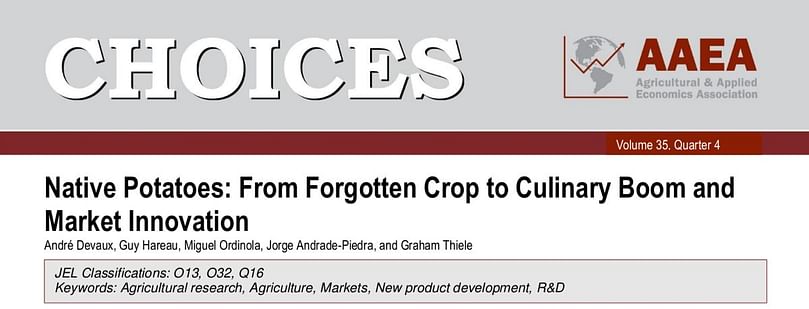
Choices Magazine: André Devaux, Guy Hareau, Miguel Ordinola, Jorge Andrade-Piedra, and Graham Thiele









